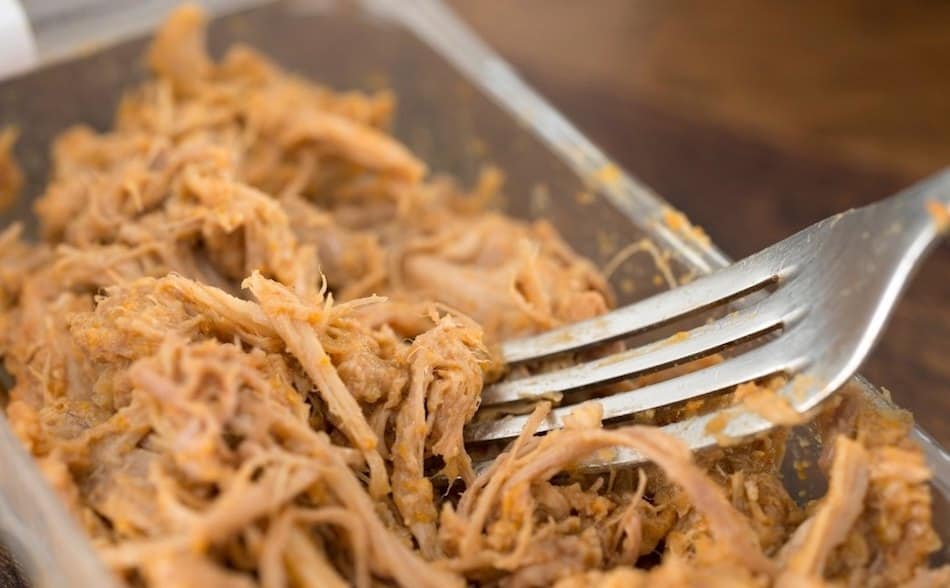
Pulled pork can dry out easily, so it’s important not to overcook it. Low-and-slow barbecue differs from traditional cooking because we cook to internal meat temperature rather than a specific time, or pound-per-hour formula. As they say, “it’s done when it’s done”. But how long is that?
Pork butt (pork shoulder) is the best cut for making pulled pork on a smoker. Cook the pork butt until it reaches an internal temperature between 195°F to 205°F. The total cook time will vary depending on the size of the roast and the cooking temperature. It takes around 8 to 10 hours to cook a pork butt for pulled pork. Allow 1.5 hours per pound when cooking at 220°F, or 1 hour per pound at 250° F.
Cooking Information |
|---|
| Pork butt (shoulder) is the best cut for pulled pork |
| Cook to internal temperature between 195°F to 205°F |
| Total cook time varies depending on size of roast and cooking temperature |
| Allow 1.5 hours per pound when cooking at 220°F, or 1 hour per pound at 250°F |
| Cooking at a higher temperature can speed up cook time |
| Wrapping the pork and not constantly opening the lid can decrease cook time |
| Spritzing too often or too soon can add extra time to the cook |
| The “stall” can occur around 160°F-170°F and add hours to the cook time |
| Pitmasters often go by “look and feel” rather than an exact internal meat temperature |
Quick Tips
- Pulled pork can dry out easily, so it’s important not to overcook it
- Cook pork butt to an internal temperature between 195°F to 205°F
- Total cook time varies depending on size of roast and cooking temperature
- Allow 1.5 hours per pound when cooking at 220°F, or 1 hour per pound at 250° F
- Cooking at a higher temperature can speed up the cook time
- Wrapping the pork at the midway point and not constantly opening the lid can also decrease cook time
- Spritzing too often or too soon can add extra time to the cook
- The “stall” can occur around 160°F-170°F and add hours to the cook time
- Pitmasters like Aaron Franklin often go by “look and feel” rather than an exact internal meat temperature
- Guides and formulas can vary depending on factors such as weather, smoker, meat, and techniques used.
When Cooking At 220°F
So when cooking at 220°F, it should take 6 hours to cook a 4 pound pork butt for pulled pork. At the same rate, allow 7.5 hours to cook a 5 pound butt, and 9 hours to cook a 6 pound roast.
Cooking Pulled Pork At 250°F
Estimating the total cook time is easier to calculate when cooking at 250°F because it works out 1 hour per pound. So at 250°F, a 5 pound butt will take around 5 hours. A 6 pound butt will take about 6 hours, a 7 pound butt will take 7 hours, and so on.
Learn To Go By “Look and Feel”
Watch a professional like Aaron Franklin cook a pork butt. He rarely uses thermometers, and doesn’t cook to specific times. Gurus like Franklin more often than not will go by “look and feel” rather than an exact internal meat temperature. You can train yourself to do the same. The more you cook, the more you will learn to know how the meat should look and feel at various stages of the cook.
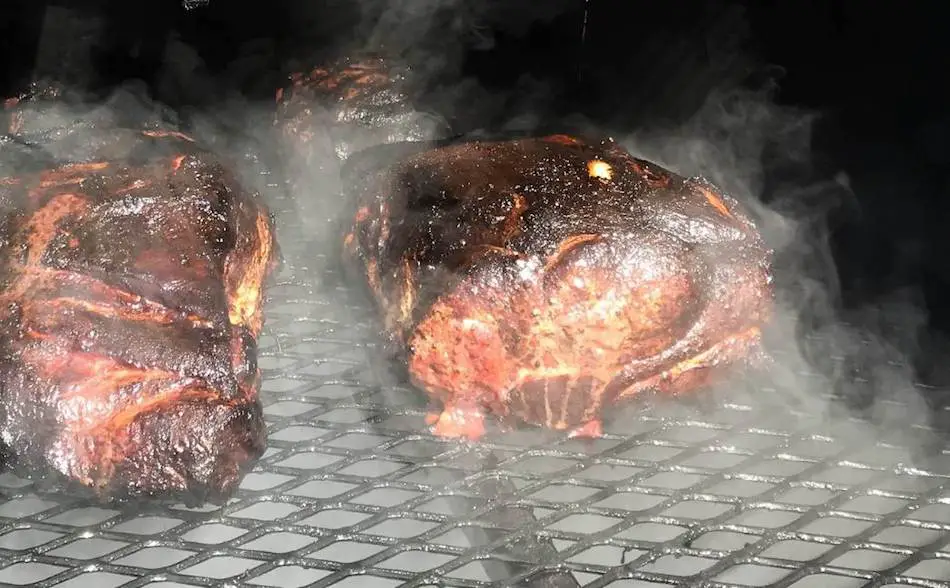
Don’t Follow “Cook Guides” Alone
When trying to figure out how long it will take to smoke pulled pork,
It’s difficult to give a total cook time. Guides will give you some kind of idea, but there are so many variables when smoking meat, so it’s hard to give an exact answer. It really depends on the weather, the type of smoker, the meat, and techniques such as wrapping and spritzing. All these things contribute to the total cook time.
How To Cook Pulled Pork Faster
One of the best ways to cook pulled pork faster is to cook at a higher temperature. Pitmaster Aaron Franklin cooked pork butt for pulled pork at around 275° F. This temperature is still within the low-and-slow range, but at the high end.
Wrapping the pork at the midway point of the cook will shave about 1 hour off the total cook time. Also, don’t keep checking the meat. Constantly opening the lid of your smoker will slow the cook and add to the total cook time.
Wrapping
There are many factors that determine the total cook time, such as climate, cooking temperatures and barbecue techniques like wrapping. By wrapping the pork in butcher paper or foil will speed up the cook and save you about 1 hour. Wrapping traps heat inside the meat, and creates steam which helps the meat cook faster and keeps the meat moist. Wrap the pork once the bark has set, which is usually about 4 or 5 hours into the cook.
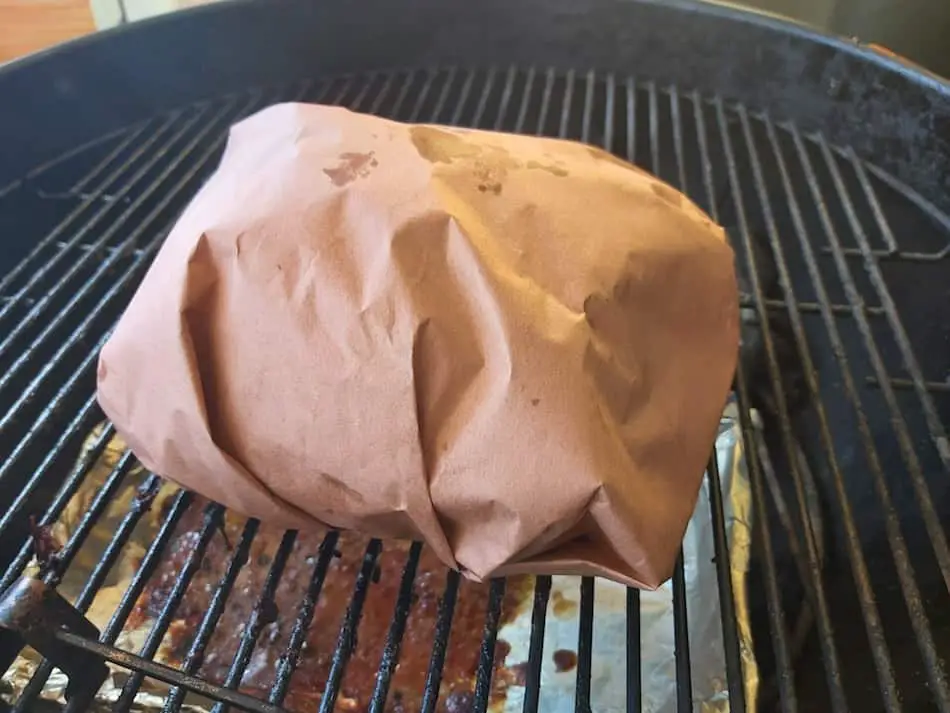
Don’t Keep Opening The Lid
If you want the meat cooked as quickly as possible, don’t keep opening the lid of your smoker. Constantly peeking at the meat will cause the meat to cook much longer than necessary. During the first 3 or 4 hours, you don’t even need to look at the meat. Opening the lid will destabilize your smoker. If it’s cold outside, you’re going to lose all that precious heat. Then your smoker is going to have to work twice as hard to come back up to temperature.
Spritzing
Spritzing too often or too soon is another thing that will also add extra time to the cook. You only need to spritz the pork after the 3 or 4 hour mark. Then, spritz intermittently (no less than 1 hour). Constantly opening the lid will suck all the heat out of your smoker and cause the pork to cook longer. When spritzing, move as fast as you can. You want to get the lid back on the smoker as soon as you can.
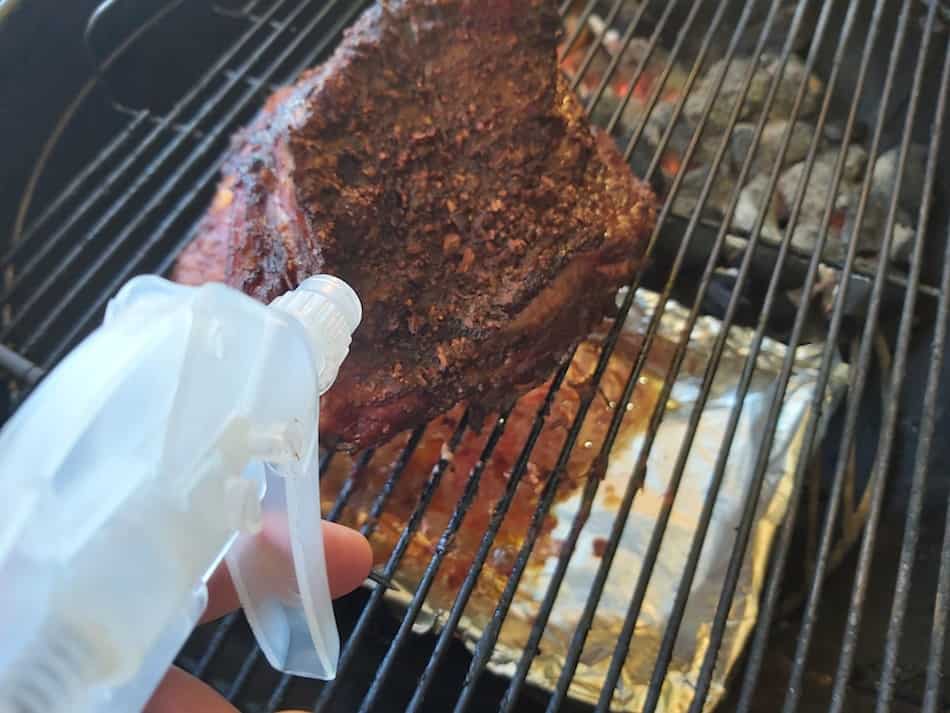
The Stall
The dreaded stall can add hours on to the total cook time. The stall usually occurs once the pork reaches an internal temp of about 160°F or 170° F. At this point, the pork’s internal temperature will stagnate. This temperature plateau can last for several hours. Sometimes the temp can even go backwards.
The best way to beat the stall is to wrap the pork in foil and increase the temperature of your cooker. Wrapping will create steam and trap the heat inside the meat. Once the pork is wrapped, bump up the temperature of your smoker from 225° F to 275° F.
The wrapping stage usually occurs once the internal temperature reaches the160° F – 170°F range.
Water Pan
I would highly recommend using a water pan when smoking pork, but the added moisture may slow the cook, making it take longer. A water pan will add moisture to the cooking environment, and will help prevent the meat from drying out. However, the water pan will suck a lot of heat out of your smoker, making the cook take longer.
What temp to cook pulled pork
The best temperature to cook pulled pork is anywhere between 225° F in 275° F. This temperature range is safe, the only difference will be time. If you’re in a hurry, cook the pork at 225°F.
Best Done Temp For Pulled Pork
Pork is safe to eat at 145°F, but it will be too chewy at this temperature. When cooking pork shoulder for pulled pork, aim for an internal temperature of 203° F. Begin checking the pork for tenderness once it reaches 190°F, then perform regular tenderness tests Once the pulled pork feels like you’re poking a stick of butter, then you’ve achieved the perfect tenderness.
How To Make Pulled Pork On A Pellet Grill
Pork Butt On A Pit Boss Pellet Grill - 12 Steps
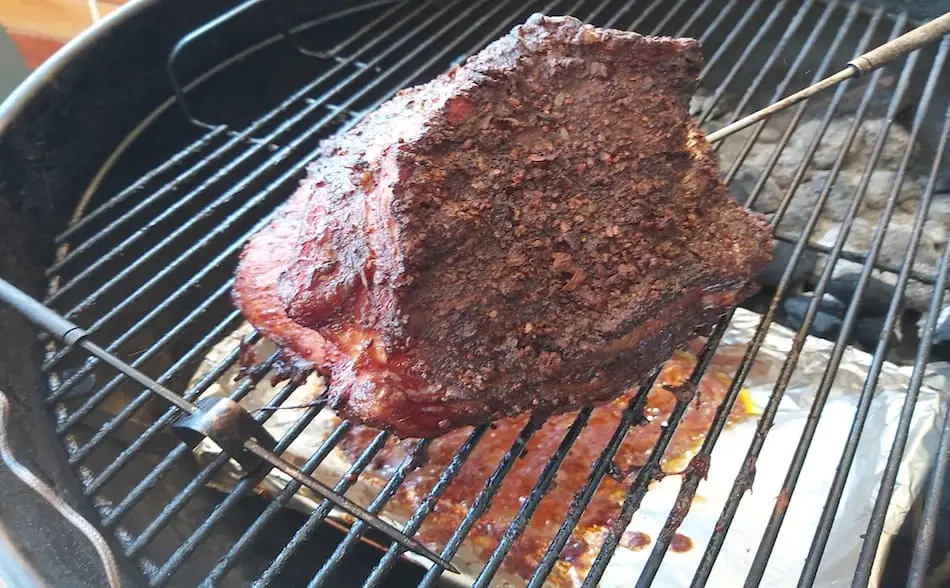
Slow smoked pork butt, ideal for pulled pork.
Ingredients
- Pork butt (Shoulder)
- Barbecue rub
- Apple cider vinegar or apple juice (spritz)
- Olive oil or yellow mustard (binder)
Instructions
- Set your PitBoss to 225°F to 250°F (or start low for 4-5 hours, then increase no higher than 275°F).
- Prepare the meat with rub and seasonings
- Place the pork fat side down (on the middle rack of a vertical PitBoss)
- Insert a thermometer probe into the meat
- Let the meat cook for 2-3 hours. Rotate the meat if there are hot spots on your PitBoss (vertical PitBoss grills are hotter towards the back).
- At the 3 to 4 hour mark, begin checking the bark on the pork with your finger. (Don’t spritz until rub has fused to the meat).
- Begin spritzing every 30 to 40 minutes once the bark has set. Use apple cider vinegar, apple juice, or plain water.
- Wrap the pork in foil once the crust has formed and internal meat temperature has reached between 160°F and 170°F.
- Continue cooking the pork butt, increasing the temperature of your PitBoss no higher than 275°F. Alternatively, turn off your PitBoss and finish in the oven.
- Once the internal meat temperature reaches 195°F, begin checking the temperature and tenderness regularly.
- Once the meat reaches 200°F to 205°F and is soft like butter, remove from the heat.
- Allow the pork to rest 30 minutes to 1 hour or place the meat into holding.
Nutrition Information:
Serving Size:
100 gramsAmount Per Serving: Calories: 168
How To Smoke Pulled Pork Like Aaron Franklin
My Favorite Meat Smoking Tools
Thanks for checking out this article. I hope you learned a few things. Here are some of my favorite tools I use when smoking brisket that may be useful to you. These are affiliate links, so if you decide to purchase any of these products, I’ll earn a commission. But in all honesty, these are the tools I recommend to my family and friends who are just starting out.
Meat Thermometer: There are dozens of fancy thermometers on the market, but I still use my trusty TP20. For around $50, I have a high-quality meat thermometer with two probes, and can track the temperature of my smoker with one probe, and my meat with the other probe. The ThermoPro TP20 is an Amazon Best Seller because it’s the easiest thermometer to operate, is durable, highly accurate, and comes with pre-programmed meat settings.
Instant Read Thermometer: Arguably, the second most important tool you need is a fast and accurate instant-read thermometer. These tools play an important role in the latter stages of the cook when the meat needs regular checking in multiple areas. I use the ThermoPro TP19 because it can do everything a ThermaPen can do, but for a fraction of the cost. You can check out the TP19 on Amazon here.
Wireless Thermometer: The latest thermometers on the market have no wires and can be controlled by wi-fi via your phone. Airprobe 3 is the best of this technology.
Butcher Paper: Wrapping brisket in butcher paper has become a huge trend in barbeque thanks to Aaron Franklin. Wrapping your brisket in paper will give you a nice brisket bark. However, you can’t just use any old paper, it has to be unwaxed, food grade paper. You can find it on Amazon here.
Advanced Thermometer and Automatic Temperature Controller: Once you’re ready to take things seriously, the FireBoard 2 Drive is a six-channel Bluetooth/Wi-Fi thermometer that can monitor up to 6 pieces of meat, control and graph your cook sessions on your smartphone, and attaches to an an automatic blower that will convert your charcoal smoker to a set-and-forget. This is one of the most advanced meat thermometers on the market. You can check it out on the FireBoard website here.
